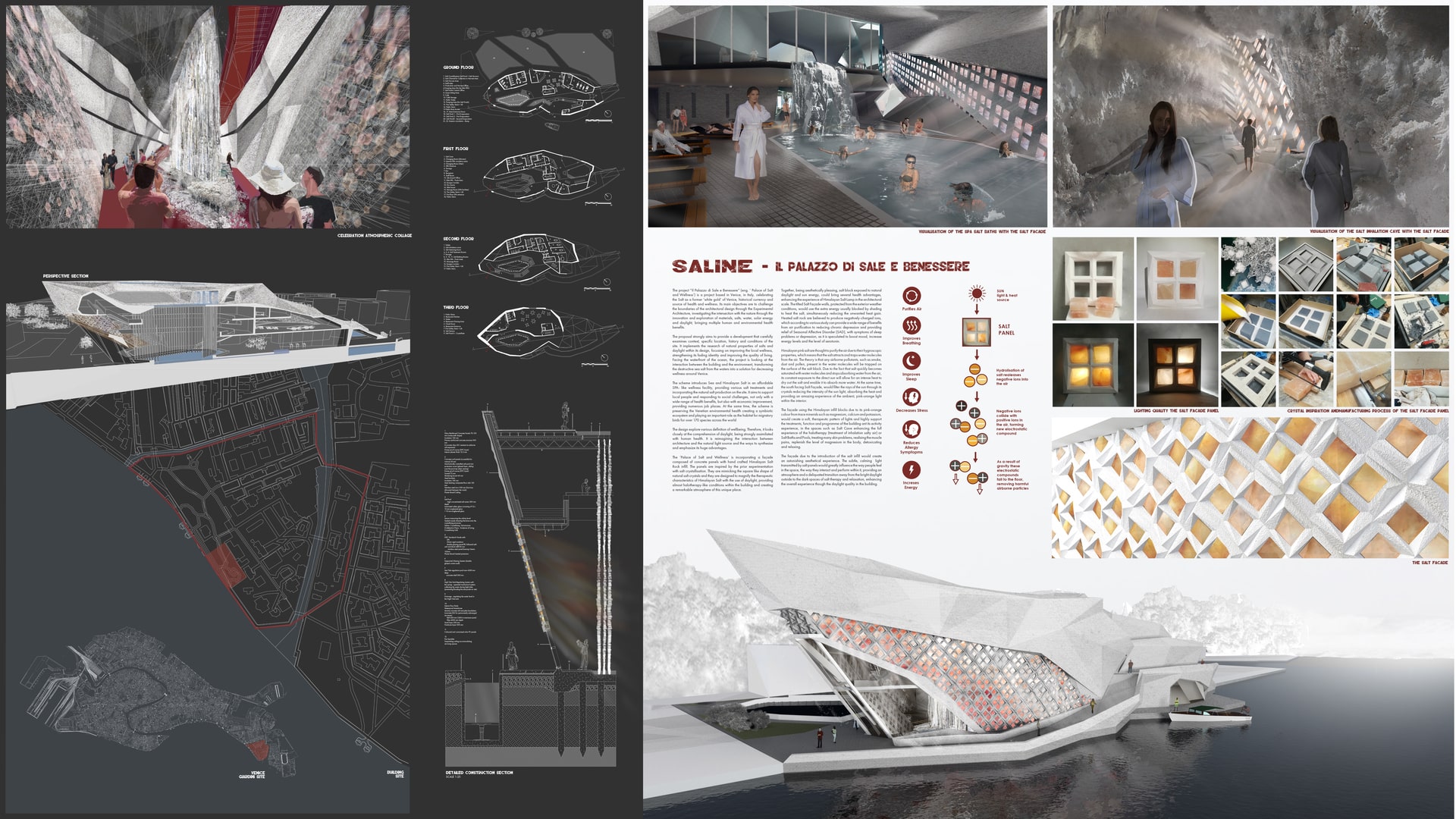Project Description
The project “Il Palazzo di Sale e Benessere” (eng. ‘ Palace of Salt and Wellness’) is a project based in Venice, in Italy, celebrating the Salt as a former ‘white gold’ of Venice, historical currency and source of health and wellness. Its main objectives are to challenge the boundaries of the architectural design through the Experimental Architecture, investigating the intersection with the nature through the innovation and exploration of materials, salts, water, solar energy and daylight, bringing multiple human and environmental health benefits. The proposal strongly aims to provide a development that carefully examines context, specific location, history and conditions of the site. It implements the research of natural properties of salts and daylight within its design, focusing on improving the local wellness, strengthening its fading identity and improving the quality of living. Facing the waterfront of the ocean, the project is looking at the interaction between the building and the environment, transforming the destructive sea salt from the waters into a solution for decreasing wellness around Venice. The scheme introduces Sea and Himalayan Salt in an affordable SPA- like wellness facility, providing various salt treatments and incorporating the natural salt production on the site. It aims to support local people and responding to social challenges, not only with a wide range of health benefits, but also with economic improvement, providing numerous job places. At the same time, the scheme is preserving the Venetian environmental health creating a symbiotic ecosystem and playing an important role as the habitat for migratory birds for over 170 species across the world The design explore various definition of wellbeing. Therefore, it looks closely at the comprehension of daylight, being strongly assimilated with human health. It is reimagining the interaction between architecture and the natural light source and the ways to synthesise and emphasize its huge advantages. The ‘Palace of Salt and Wellness’ is incorporating a façade composed of concrete panels with hand crafted Himalayan Salt Rock infill. The panels are inspired by the prior experimentation with salt crystallisation. They are mimicking the square like shape of natural salt crystals and they are designed to magnify the therapeutic characteristics of Himalayan Salt with the use of daylight, providing almost halotherapy-like conditions within the building and creating a remarkable atmosphere of this unique place. Together, being aesthetically pleasing, salt block exposed to natural daylight and sun energy, could bring several health advantages, enhancing the experience of Himalayan Salt Lamp in the architectural scale. The tilted Salt Façade walls, protected from the exterior weather conditions, would use the extra energy usually blocked by shading to heat the salt, simultaneously reducing the unwanted heat gain. Heated salt rock are believed to produce negatively-charged ions, which according to various study can provide a wide range of benefits from air purification to reducing chronic depression and providing relief of Seasonal Affective Disorder (SAD), with symptoms of sleep problems or depression, as it is speculated to boost mood, increase energy levels and the level of serotonin. Himalayan pink salt are thought to purify the air due to their hygroscopic properties, which means that the salt attracts and traps water molecules from the air. The theory is that any airborne pollutants, such as smoke, dust and pollen, present in the water molecules will be trapped on the surface of the salt block. Due to the fact that salt quickly becomes saturated with water molecules and stops absorbing water from the air, its constant exposure to the direct sun will allow for an intense heat to dry out the salt and enable it to absorb more water. At the same time, the south facing Salt Façade, would filter the rays of the sun through its crystals reducing the intensity of the sun light, absorbing the heat and providing an amazing experience of the ambient, pink-orange light within the interior. The façade using the Himalayan infill blocks due to its pink-orange colour from trace minerals such as magnesium, calcium and potassium, would create a soft, therapeutic pattern of lights and highly support the treatments, function and programme of the building ant its activity experience, in the spaces such as Salt Cave enhancing the full experience of the halotherapy (treatment of inhalation salty air) or Salt Baths and Pools, treating many skin problems, realising the muscle pains, replenish the level of magnesium in the body, detoxicating and relaxing. The façade due to the introduction of the salt infill would create an astonishing aesthetical experience. The subtle, calming light transmitted by salt panels would greatly influence the way people feel in the space, the way they interact and perform within it, providing an atmosphere and a deliquated transition away from the bright daylight outside to the dark spaces of salt therapy and relaxation, enhancing the overall experience though the daylight quality in the building.
